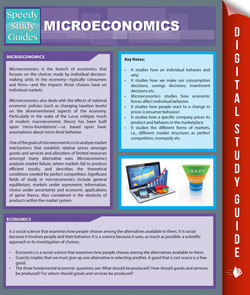Читать книгу Micro-Economics (Speedy Study Guides) - Speedy Publishing - Страница 2
На сайте Литреса книга снята с продажи.
ОглавлениеMICROECONOMICS
Microeconomics is the branch of economics that focuses on the choices made by individual decision-making units in the economy—typically consumers and firms—and the impacts those choices have on individual markets.
Microeconomics also deals with the effects of national economic policies (such as changing taxation levels) on the aforementioned aspects of the economy. Particularly in the wake of the Lucas critique, much of modern macroeconomic theory has been built upon ’micro-foundations’—i.e. based upon basic assumptions about micro-level behavior.
One of the goals of microeconomics is to analyze market mechanisms that establish relative prices amongst goods and services and allocation of limited resources amongst many alternative uses. Microeconomics analyzes market failure, where markets fail to produce efficient results, and describes the theoretical conditions needed for perfect competition. Significant fields of study in microeconomics include general equilibrium, markets under asymmetric information, choice under uncertainty and economic applications of game theory. Also considered is the elasticity of products within the market system.
ECONOMICS
Is a social science that examines how people choose among the alternatives available to them. It is social because it involves people and their behavior. It is a science because it uses, as much as possible, a scientific approach in its investigation of choices.
• Economics is a social science that examines how people choose among the alternatives available to them.
• Scarcity implies that we must give up one alternative in selecting another. A good that is not scarce is a free good.
• The three fundamental economic questions are: What should be produced? How should goods and services be produced? For whom should goods and services be produced?
Key Notes:
• It studies how an individual behaves and why
• It studies how we make our consumption decisions, savings decisions, investment decisions etc.
• Microeconomics studies how economic forces affect individual behavior.
• It studies how people react to a change in prices (consumer behavior)
• It studies how a specific company prices its product and behaves in the marketplace
• It studies the different forms of markets, i.e., different market structures as perfect competition, monopoly etc.
